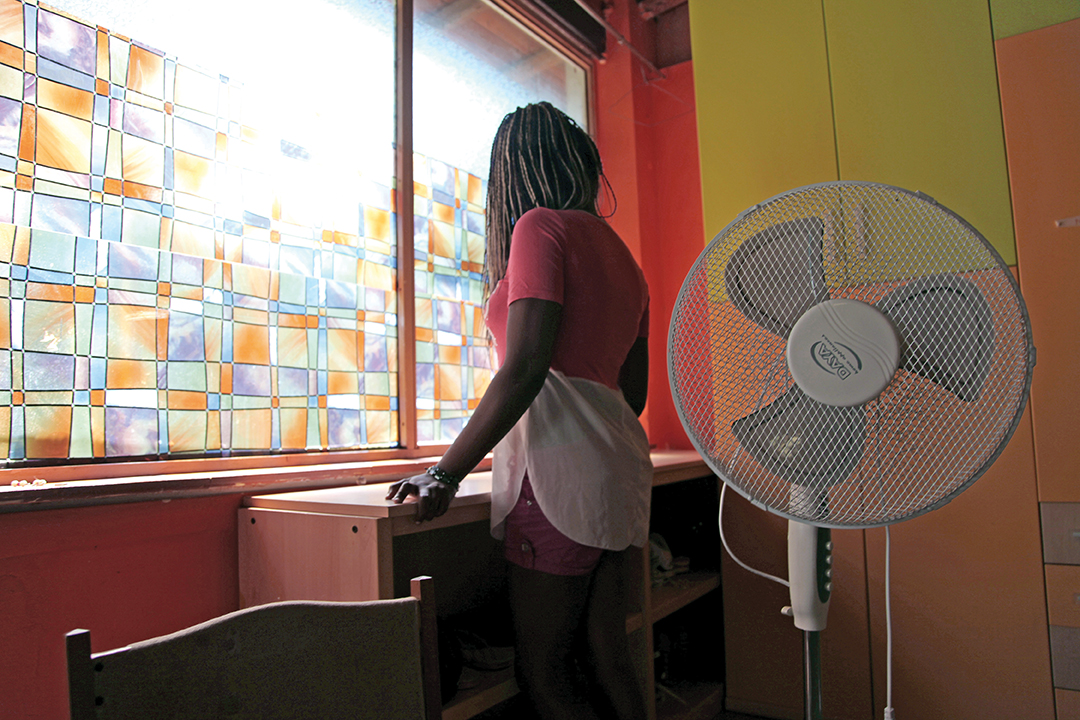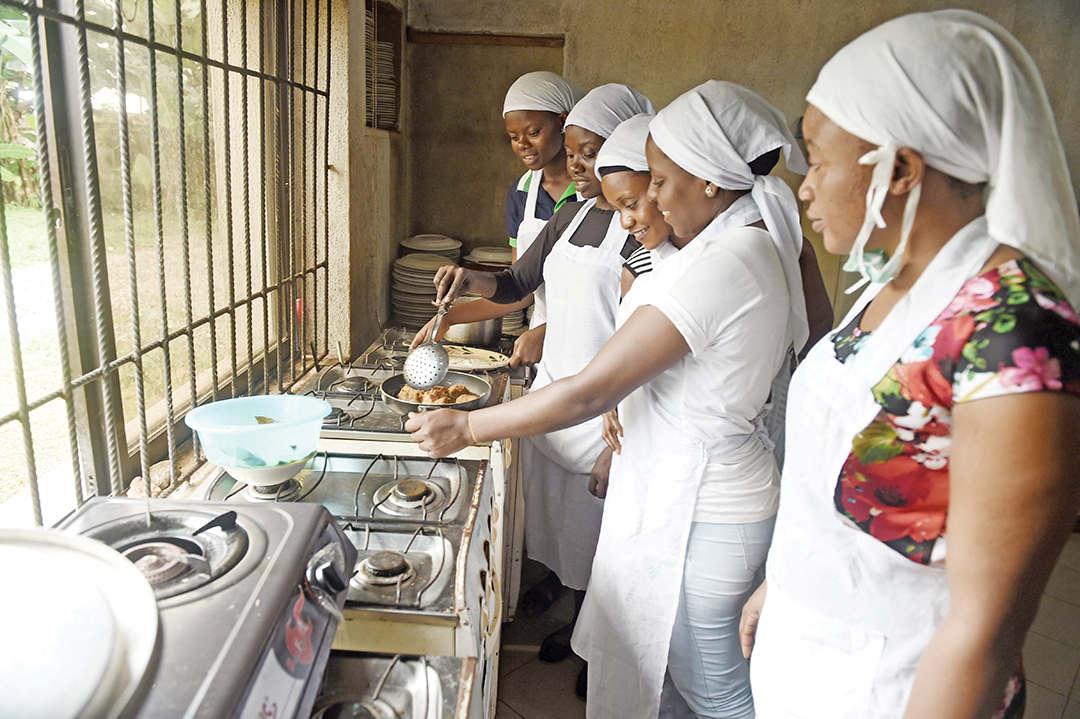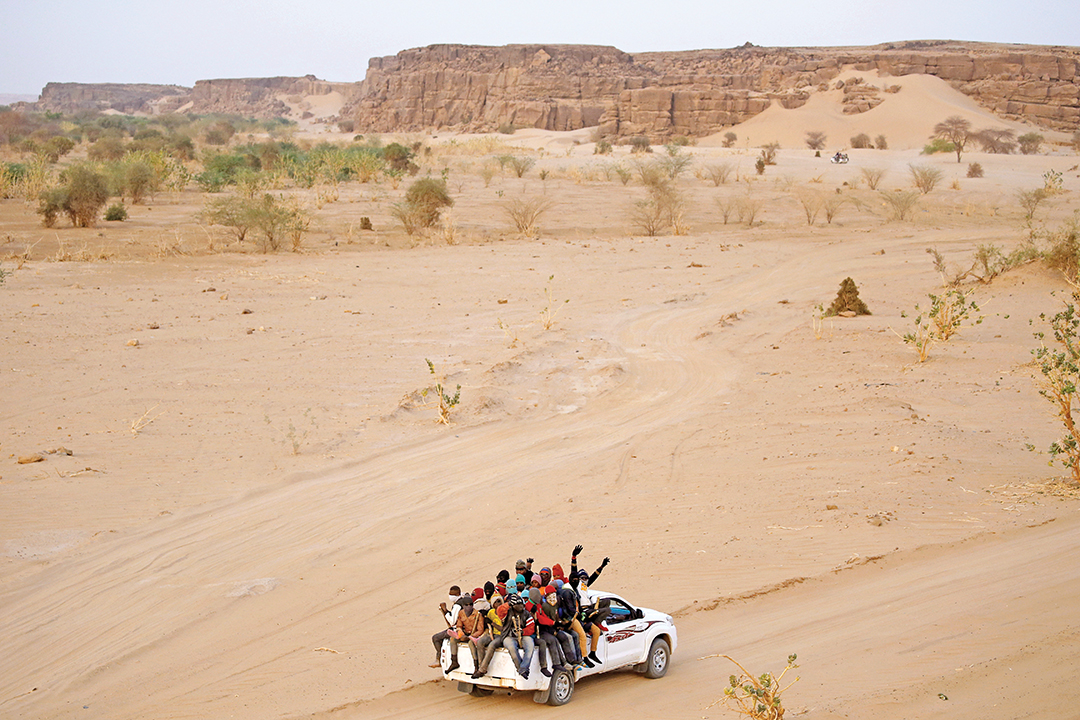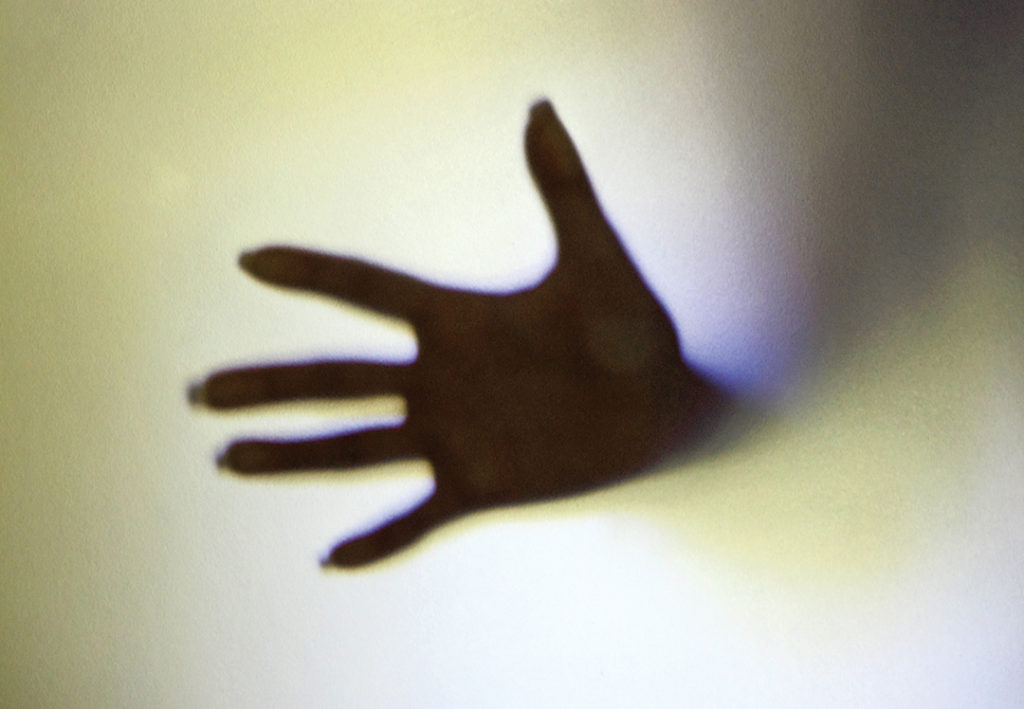Human Trafficking Is a Global Problem, but One Program Provides Hope
ADF STAFF
When seasonal rains fall in Gloria Erobaga’s small village in Nigeria’s Edo State, the crude dirt roads soften and wash away, making access nearly impossible. The same rains form pools on the floors of her school, which sits in disrepair a 90-minute walk away. Homes have no electricity, and families live cramped in the small mud-brick structures.
So when someone visits with a promise that a girl can have travel to Europe, get a guaranteed job and a university education, some families are eager to agree. Finally, their daughters will get what they cannot get at home.
However, as Erobaga told Al-Jazeera’s People & Power in 2013, the promises are empty. The only opportunities are the misery of prostitution and hopeless debt. “I dreamt about going to school and getting married, but it’s not easy,” Erobaga said. “A family friend came to meet my parents and said they needed a girl. My parents have a lot of children, so they said they just wanted to help my parents by taking me abroad. They said my dad shouldn’t worry, that when I got there they’d put me in school, continue my education, going to university, I’ll get a good job, and I said OK.”

The United Nations has estimated that 10,000 Nigerian girls are working as prostitutes in Italy. Many others end up scattered throughout Europe — in Spain, Greece, Belgium and elsewhere. Sometimes, the Nigerian girls end up in North America.
Criminals force young women like Erobaga to work off their transit debts on the streets. These debts can be as high as $80,000. The work also puts the girls under control of murderous criminal gangs, including some based in Africa that have spread to Europe and beyond. “I was so scared,” Erobaga said. “Because the mafia just go out with guns on the streets, looking for who they are going to kill to collect their money and their blood. They kill them and just cut them and put them in the waste bin. Just like that. They treat us like slaves.”
A CRIMINAL ENTERPRISE
Italian authorities eventually deported Erobaga, so she returned to her hometown, Benin City, Nigeria, the epicenter of West Africa’s human trafficking industry. Most Nigerian women who end up on the European streets came from Benin City in Edo State. Many of the stories of how traffickers approach and lure them into prostitution are similar.
An intelligence official with Nigeria’s National Agency for the Prohibition of Trafficking in Persons (NAPTIP) told Al-Jazeera that the process typically involves people working at three levels:
- An agent recruits the girls. He or she knows something about the victim, where she lives and her family.
- A trolley, sometimes known as a coyote, handles transportation for those being trafficked.
- A madam handles the girls once they reach their destinations. Sometimes these madams were trafficked themselves. They collect money and pay off Nigerian gangsters.
Once a girl is identified for transport abroad, agents will take her to a local “juju priest,” who will collect pubic hair, blood and nail clippings for a ritual that binds her to a pledge. An escape attempt or any failure to pay off her debt, she is told, could result in her death or the death of family members. The psychological threat of the juju oath is so powerful that NAPTIP officials sometimes employ these same priests to perform a ceremony releasing the girls from their oaths so they will cooperate in prosecutions.
AFRICAN GANGS PARTICIPATE
Human traffickers make $150 billion a year in profit, and nearly two-thirds of that comes from commercial sexual exploitation, according to the International Labor Organization.
Unsurprisingly, criminal networks often are involved at every level of the process. Among the most notorious and dangerous in Nigeria is a group known as the Black Axe, which emerged from the Neo Black Movement of Africa. This and other Nigerian gangs have spread beyond Africa and into Europe and North America in recent years.
Seventeen members of the Black Axe mafia were arrested in late 2016 in Italy, according to a Los Angeles Times report. “Our probe showed how gangs like the Black Axe are running the whole prostitution pipeline, which brings trafficked women from Nigeria to Italy,” said an investigator in Palermo.

The groups also have taken root in Spain, Reuters reports. Organized crime controls virtually all prostitution in Catalonia, “much of it by a dominant Nigerian crime group known as the Supreme Eiye Confraternity or Air Lords.”
Charlotte Baarda, a Ph.D. student at the University of Oxford in England who specializes in the study of human trafficking from Nigeria to Europe, told ADF that Nigerian gangs such as the Black Axe operate on both ends of the trafficking route, but in different ways.
In Nigeria, the starting point, larger groups may operate a travel agency, recruit people for transit and prepare them for the journey to Europe. In Europe, however, criminals are more likely to spread out the risk by breaking tasks into smaller segments. In fact, traffickers farm out some work to trolleys who may not even know they are consorting with a criminal network.
“So friends of friends are asked to house a couple of women for a few nights until they can be brought to the madam or asked to approach an asylum center and pick up a couple of people,” Baarda said. “In the sense that these people who do that actual job are not part of the criminal group necessarily, but are just kind of on an ad hoc basis.”
Human trafficking does not have to be masterminded by large transnational criminal networks to be successful. A 2014 United Nations Office on Drugs and Crime (UNODC) report shows that trafficking can be carried out by one or two people. For example, a shop owner could easily deceive a young girl and serve her up for sexual exploitation by his clients. Such “nonorganized” human trafficking is common around the world. The risks are lower because there is no need to send victims across national borders.
Criminals also can conduct trafficking subregionally. A case in Lithuania involved five local citizens who recruited underage girls from Baltic nations and sold them to other gangs in Western Europe, where they were exploited. So the crime occurs on multiple levels, each requiring different amounts of coordination and risk.
PROGRAM WORKS TO BUILD CAPACITY
Human trafficking and the overlapping but separate problem of migrant smuggling challenge nations and law enforcement officials all over the world. But in 2015, work began on a new program to combat the problem comprehensively. Efforts ramped up in January 2017.
The Global Action to Prevent and Address Trafficking in Persons and the Smuggling of Migrants (GLO.ACT) is jointly funded by the European Union and UNODC and will be delivered through 2019. GLO.ACT also works in partnership with the International Organization for Migration (IOM) and the United Nations Children’s Fund (UNICEF).
GLO.ACT is working in 13 countries worldwide, including five in Africa: Egypt, Mali, Morocco, Niger and South Africa. The other countries are Belarus, Brazil, Colombia, Kyrgyz Republic, Laos, Nepal, Pakistan and Ukraine.
Margaret Akullo, project coordinator for GLO.ACT in UNODC’s Vienna office, told ADF the program intends to help build capacity and increase knowledge among criminal justice officials and others who deal with trafficking, organized crime and smuggling of migrants, while also supporting victims. The hope is that the number of investigations and prosecutions can increase, and national laws can be matched to international standards, while also raising awareness and supporting victims. The program will work toward those goals through six objectives:
- Strategy and policy development: UNODC will work with countries to develop strategies and policies to address human trafficking and migrant smuggling.
- Legislative assistance: UNODC will work with governments to make sure domestic laws, policies and strategies meet international standards for criminalizing human trafficking and migrant smuggling.
- Capacity building: Governmental authorities and UNODC will build the capacity and knowledge of criminal justice practitioners to combat human trafficking, migrant smuggling, and to also help and protect victims.
- Regional and transregional cooperation: UNODC will promote cooperation and information-sharing with law enforcement on the identification, investigation and prosecution of offenses related to human trafficking and migrant smuggling.
- Protection and assistance to trafficking and smuggling victims: The IOM will work with governments and civil society to develop assistance and support programs for victims.
- Help to children who are victims of trafficking and smuggling: UNICEF and IOM will work with victim support services and relevant government authorities to help develop ways to protect children.
Aimée Comrie, a crime prevention and criminal justice officer at UNODC and the policy lead for GLO.ACT, said there has been “tremendous progress” in addressing human trafficking. Most countries have laws addressing the crime, “But we don’t see those numbers in terms of the cases; we don’t see the victims being identified or the cases going forward or being successful,” Comrie said. “So it’s kind of a question of taking that structure that’s already existing and trying to tailor our work to each country, to the context, and see how can we make it more effective in that country.”
The program already has been able to log a few early successes. In November 2016, Morocco passed a new trafficking law, so GLO.ACT held a capacity-building workshop on human trafficking in Rabat for 23 social workers and others employed by the criminal court system. In Cairo, GLO.ACT and government officials held an event in December 2016 to raise awareness about a new law on combating illegal migration and smuggling of migrants.
THE ROLE OF MILITARIES
GLO.ACT is guided primarily by ongoing consultations with national governments, so whether the project’s work involves militaries and gendarmeries will depend on the needs and desires of individual countries, Akullo said.
A December 20, 2016, United Nations Security Council Resolution calls on member nations to work together to combat human trafficking, especially in conflict zones that involve peacekeeping missions. Conflicts produce migrants and a breakdown in law and civil order, so it is likely that Soldiers will encounter human trafficking at some point. Militaries also work border posts and provide coastal security, which is where they are likely to detect migrant smuggling and trafficking.
Human trafficking victims will be mixed with asylum seekers, smuggled migrants and irregular migrants, so this means predeployment training will be crucial.
National militaries also may encounter human trafficking in other ways, including through procurement and supply chain activity. Human trafficking and forced labor exist in various sectors such as manufacturing, fisheries, construction, clothing and domestic work. Large-scale military procurement will have to avoid supporting trafficking.
“I think there’s a role for everyone,” Comrie said. “It’s a crime that crosses all sectors of society, all regions of the world, all countries of the world; there’s nowhere that’s immune to the problem.”
Human Trafficking: A Definition
ADF STAFF
Human trafficking is an insidious practice that takes many forms and affects people of all ages, male and female. According to the United Nations’ 2000 Protocol to Prevent, Suppress and Punish Trafficking in Persons, trafficking is the “recruitment, transportation, transfer, harbouring or receipt of persons” by threat or use of force, fraud, coercion, abduction, abuse of power or position of vulnerability, or payment or benefits for the purpose of exploitation.
Despite the term, the condition does not require movement. A person born into servitude can be considered a trafficking victim, and people can be exploited without ever leaving their hometowns.
Human trafficking also can take many forms, depending on the intent of the criminal enterprise doing the trafficking. Interpol notes some of the ways this crime manifests itself in Africa and elsewhere:
- Trafficking for forced labor: These victims mostly come from developing countries and are recruited through coercion and deception. Criminals keep them in slave-like conditions as they work as domestics or in construction, fisheries and agriculture.
- Trafficking in women for sexual exploitation: This worldwide scourge lures women and children by promising good jobs in another region or country, such as the thousands of women who leave Africa for Europe. When they arrive, they find themselves hopelessly in debt and trapped in sexual slavery through prostitution.
- Commercial sexual exploitation of children in tourism: This crime has been common in Asia for many years, but it has grown in Africa and Central and South America. It thrives because of “the relatively low risk of prohibition and prosecution in these destinations for engaging in sexual relations with minors.”
- Trafficking for tissue, cells and organs: Trafficking for organs, particularly kidneys, is a growing crime as traffickers exploit desperate patients and potential donors amid long transplant waiting lists. Often surgeries are performed without medical follow-up.
Migrant smuggling is closely connected to trafficking. Criminal networks take advantage of migrant flows to and through the Mediterranean region for financial gain.
However, there are four differences between human trafficking and people smuggling, according to the United Nations Office on Drugs and Crime. Smuggling involves consent and involves migrants arriving at their destination. Trafficking victims are exploited without consent. Smuggling always is transnational, but trafficking may not be. Finally, the two differ in terms of profit sources. In smuggling, profits are generated by the transportation, illegal entry or stay in another country. Trafficking profits come from exploitation.
Agadez, Niger, a Hub for Smuggling People
ADF STAFF
Agadez, an ancient city in central Niger, has for centuries been a hub of trade routes for the Sahel and Sahara region. Those who smuggle migrants still use the city as the starting point for a perilous trek across the hot desert sands on the way into Libya, and eventually on to the Mediterranean. At the coast, a dangerous journey to Europe begins, one often fraught with tragedy and death.
People from all over West Africa make their way to Agadez, where smugglers load them into pickup trucks, often with other hidden contraband. Men and women wrap their faces against the sun and sand, then straddle wooden sticks lodged in the truck beds to keep from being thrown off and left behind. Those who willingly pay smugglers for transit can become unwittingly ensnared in human trafficking in conditions such as these.

“We even see links between the illicit smuggling organizations and the trafficking organizations,” said Aimée Comrie, policy lead for the United Nations Office on Drugs and Crime’s Global Action to Prevent and Address Trafficking in Persons and the Smuggling of Migrants. “They even sometimes diversify the labor amongst themselves.” It is important to note, she said, that a migrant’s consent at the beginning does not absolve a trafficker of criminal culpability.
In Agadez, often the first stop for Nigerian sex traffickers, women sometimes are repeatedly raped by traffickers and others, an International Organization for Migration official told Huffington Post. The women earn $3 per sex act, which goes to a pimp, whom they owe for “travel expenses.” Then they are taken to Libya, where they suffer additional sexual violence until they board boats for European brothels.
In October 2016, Germany pledged support to Niger. Chancellor Angela Merkel said her nation would send $86 million, military vehicles and other equipment to Niger to help it fight human traffickers and militant Islamists, Reuters reported.
President Mahamadou Issoufou welcomed the help, but he said Niger’s financial needs are about $1 billion, Reuters reported. “We need massively more aid,” he said.

